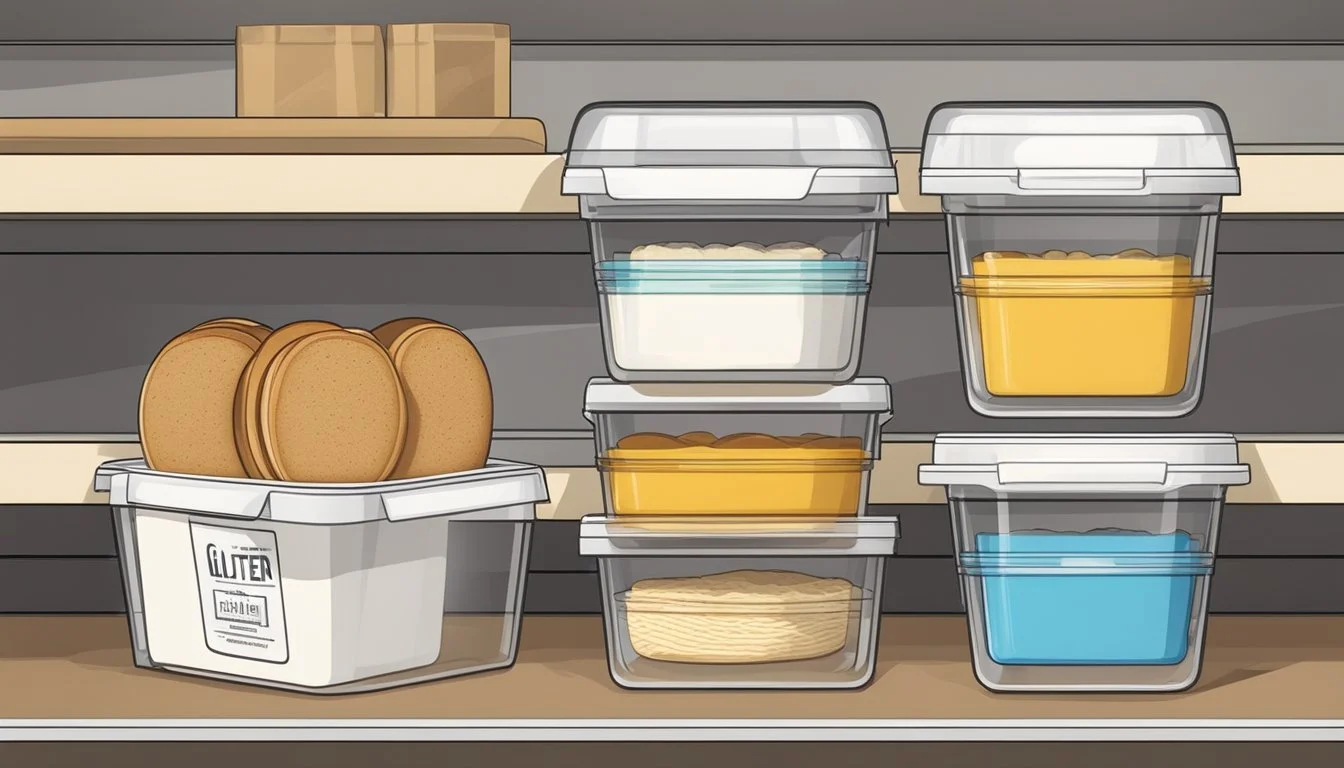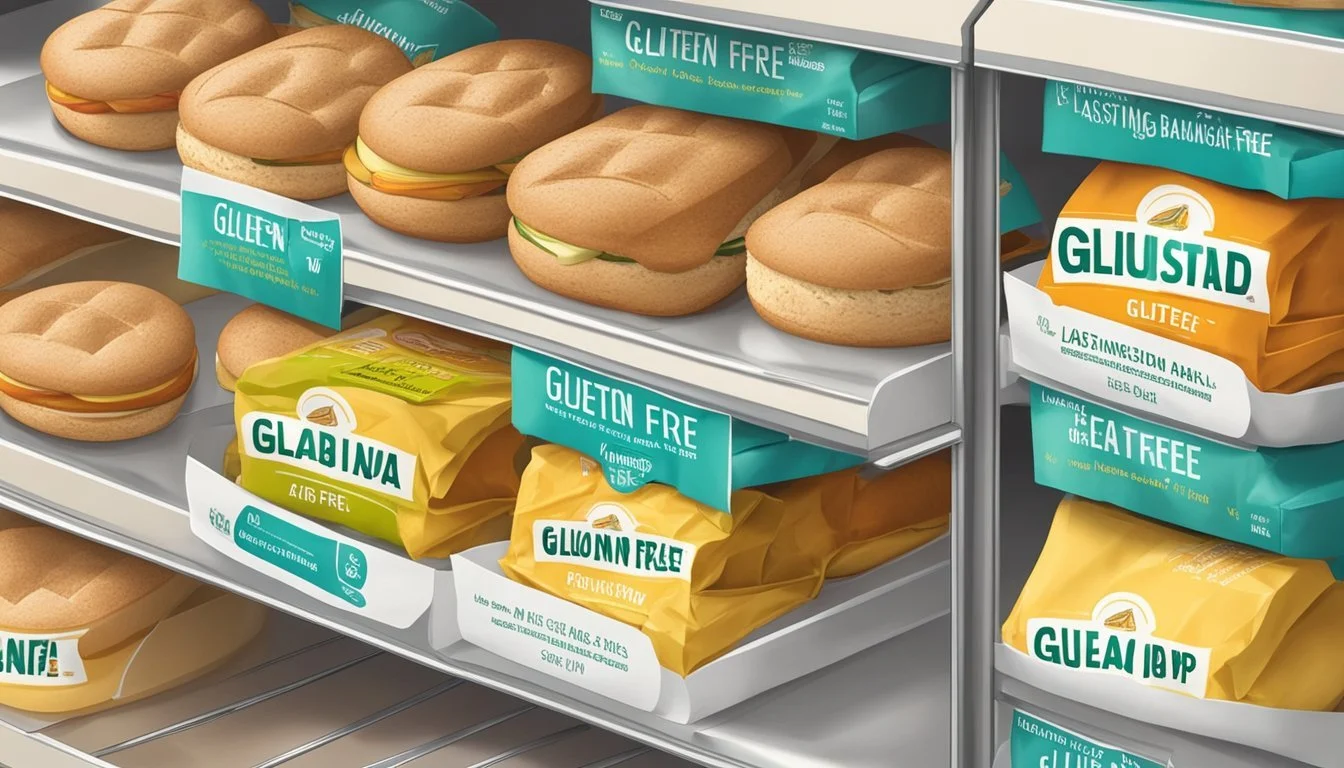How Long Do Gluten-Free Breakfast Sandwiches Last?
Storage Tips and Guidelines
Wondering how long your gluten-free breakfast sandwiches will last? These convenient and healthy meals are a great option for those avoiding gluten, but it's essential to know the best way to store them to maintain freshness and safety. Properly stored in the fridge, gluten-free breakfast sandwiches can last up to five days.
Gluten-free breakfast sandwiches can be prepared in advance and stored in the refrigerator or freezer for added convenience. When stored in the freezer, they can last up to three months without compromising quality. Packaging them in aluminum foil and sealing them in a Ziploc bag ensures they stay fresh and are easy to reheat.
When reheating your sandwiches, ensure they reach an internal temperature of 165°F to ensure they're safe to eat. Reheating options include microwaving for a minute or placing them in a 350°F oven for about 15 minutes. These methods guarantee your gluten-free breakfast sandwiches are both delicious and safe, no matter how long they've been stored.
Understanding Gluten-Free Breakfast Sandwiches
Gluten-free breakfast sandwiches provide a delicious and healthy alternative for those with gluten intolerance or celiac disease. These sandwiches can be prepared with a variety of ingredients, offering flexibility in flavors and dietary preferences.
Ingredients and Alternatives
The ingredients for gluten-free breakfast sandwiches are diverse, allowing for both traditional and creative recipes. Common bases include gluten-free breads, bagels, English muffins, pancakes, and even waffles. Popular fillings consist of eggs, bacon, sausage, and ham.
For those seeking dairy-free options, dairy-free cheese, butter alternatives, and avocados can be used. Additional toppings like spinach, tomato, salsa, and various veggies add nutrition and flavor.
For a vegan alternative, one might consider using tofu scramble instead of eggs and plant-based sausages.
The Role of Gluten in Sandwiches
Gluten is a protein found in wheat, barley, and rye, which gives bread its elasticity and chewy texture. In gluten-free sandwiches, alternative grains and flours, such as rice flour, almond flour, and tapioca starch, are used to replicate this texture without causing adverse reactions in individuals with gluten sensitivities.
The choice of gluten-free bread is crucial for maintaining the structural integrity of the sandwich. The use of gluten-free tortillas or waffles can provide additional texture options and variety.
Protein-rich fillings like eggs and cheese are pivotal in ensuring the sandwich is not only satisfying but also nutritious.
Preparing Gluten-Free Breakfast Sandwiches
To make a delicious gluten-free breakfast sandwich, it's crucial to get the right recipe components and use effective cooking techniques.
Recipe Composition
A well-composed gluten-free breakfast sandwich requires specific ingredients. Start with gluten-free bread, which can be homemade or bought from the store. Common choices include rolls, bagels, or even slices of gluten-free bread.
Next, choose your protein source. Popular options are scrambled eggs, bacon, sausage, or ham. For a vegetarian alternative, consider including a tofu scramble.
Add healthy fats such as avocado slices or dairy-free cheese to enhance flavor. To assemble, layer your ingredients ensuring even distribution for consistent taste in each bite.
Lastly, for those who prefer a sweet and savory mix, adding a thin layer of gluten-free spread can make a delightful contrast.
Cooking Techniques
The methods used to cook gluten-free breakfast sandwiches impact their texture and flavor. Begin by preheating your oven or toaster oven to 350°F for baking the bread. This ensures a crispy exterior and a warm, soft interior. Alternatively, for a quicker option, use a microwave but be cautious as it can make the bread soggy.
Cooking proteins like bacon or sausage on a stovetop pan allows for greater control over doneness. Eggs can be scrambled in a non-stick pan or baked in a muffin tin for uniform pieces.
For make-ahead meals, assemble and wrap sandwiches in aluminum foil for freezer storage. Reheat them in the oven or toaster oven to maintain texture, avoiding microwaves if possible for the best results.
Careful balance between prep time, cook time, and baking techniques will yield a satisfying gluten-free breakfast sandwich.
Storage Solutions for Gluten-Free Breakfast Sandwiches
When storing gluten-free breakfast sandwiches, it's crucial to understand both short-term and long-term options to ensure they maintain their taste and texture.
Short-Term Storage
For short-term storage, keep your gluten-free breakfast sandwiches in the refrigerator. After preparing the sandwiches, allow them to cool to room temperature.
Wrap each sandwich individually in parchment paper or aluminum foil. Store them in an airtight container or a resealable plastic bag to prevent moisture loss and contamination. They can be stored in the fridge for 3-4 days.
When ready to eat, you can reheat the sandwiches in the oven at 350°F for about 10-15 minutes or in a microwave for 1-2 minutes until warm.
Long-Term Freezing
For long-term freezing, ensure your gluten-free breakfast sandwiches are adequately cooled before wrapping. Individually wrap each sandwich tightly with aluminum foil or plastic wrap. To avoid freezer burn, place the wrapped sandwiches in a large, resealable freezer bag or an airtight container.
Label the packaging with the preparation date. Gluten-free breakfast sandwiches can be stored in the freezer for up to 2 months.
To reheat, there's no need to thaw them. Preheat your oven to 350°F and place foil-wrapped sandwiches directly in the oven for 45-60 minutes or warm them in a microwave for 2-4 minutes on high.
Serving and Reheating Instructions
When it comes to serving and reheating gluten-free breakfast sandwiches, using the right methods can ensure they retain their delicious flavor and texture. Whether using a microwave, oven, or toaster oven, it’s important to follow specific steps for the best result.
Optimal Reheating Methods
Microwave: For a quick and easy option, reheating in the microwave is perfect for grab-and-go mornings. Unwrap the sandwich from foil and place it on a microwave-safe plate. Heat on medium for 1-2 minutes until warmed through.
Oven: Preheat to 350°F (175°C). Place the unwrapped sandwich on a baking sheet and cover with foil. Bake for 15-20 minutes until heated thoroughly. This method helps retain the sandwich’s crispness.
Toaster Oven: Similar to the oven method but faster. Set the toaster oven to 350°F and heat the sandwich wrapped in foil for about 10-15 minutes. This method crisps up the bread while evenly warming the insides.
Serving Suggestions
Classic Pairings: Serve the sandwich with a side of yogurt and fresh fruit for a balanced and nutritious meal. Avocado slices and sprouts make a fantastic topping for a fresh, healthy twist.
Sriracha Sauce: Add a dash of sriracha sauce for a spicy kick. It pairs well with the flavors of the breakfast sandwich, adding an exciting touch to your morning.
Versatile Options: These sandwiches are versatile and can be customized with various toppings or sides. Consider adding cheese, tomatoes, or bacon to suit your taste.
By following these methods and suggestions, you can enjoy a delicious and satisfying gluten-free breakfast sandwich any day of the week.
Nutritional Considerations
When considering nutritional aspects, gluten-free breakfast sandwiches are diverse and can cater to various dietary needs. These sandwiches can be tailored to be dairy-free, high in protein, and low in calories, depending on the ingredients used.
Calories:
The calorie content of gluten-free breakfast sandwiches varies. Ingredients like avocados and eggs can add healthy fats and nutrients, while lean proteins like turkey or chicken can keep the calories moderate.
Protein:
Protein is essential for a satisfying breakfast. Options like eggs, turkey, and tofu are great sources of protein. A gluten-free breakfast sandwich with these ingredients can provide 10-20 grams of protein per serving, supporting muscle repair and overall health.
Dairy-Free:
It's possible to make sandwiches dairy-free by substituting with plant-based cheeses or using ingredients like hummus and avocado. These alternatives can offer similar textures and flavors without the lactose.
Gluten-Free:
Ensuring the sandwich is truly gluten-free involves using gluten-free bread and checking for any cross-contamination. Several brands offer gluten-free bread, and many recipes provide homemade options to avoid gluten altogether.
Example Nutritional Breakdown:
Ingredient Calories Protein (g) Dairy-Free Gluten-Free Gluten-free bread 90 2 Yes Yes Avocado (half) 120 2 Yes Yes Egg 70 6 Yes Yes Turkey slice 30 5 Yes Yes
This diverse range of ingredients ensures that gluten-free breakfast sandwiches can meet varying dietary needs while providing essential nutrients.
Creative Variations and Add-Ons
Gluten-free breakfast sandwiches offer a versatile base to start your day with a variety of creative add-ons.
Variations can be as simple as switching out American cheese for a sharper cheddar or a creamy brie.
Layering bacon brings a savory crunch, while turkey sausage provides a leaner protein option.
Veggies like spinach, sliced tomato, and red onion not only add color but also pack in extra nutrients.
For a spicy kick, add buffalo sauce or a few slices of jalapeño.
Prepping the ingredients ahead of time can make assembly quick and efficient.
Eggs can be whisked with salt and pepper and cooked in advance, while red onion and tomato slices can be prepped the night before.
Make-ahead options are a game-changer. Assemble the sandwiches and wrap them in aluminum foil.
Store in the fridge for a quick reheat in the oven or microwave the next morning.
For a dairy-free twist, swap out traditional cheese with a dairy-free alternative and spread avocado instead of butter for a creamy texture.
The variety in ingredients means there’s a combination for every taste preference.
Tips for Meal Prep and Busy Mornings
For those hectic mornings, meal prep can save time and ensure a nutritious start to the day.
Prepare ingredients in advance. Pre-cook breakfast sausage patties, whisk and season eggs, and have your choice of cheese ready.
Freezer-friendly breakfast sandwiches can be a lifesaver. Wrap each sandwich in foil or parchment paper and store them in airtight containers or freezer bags.
Use a 9×13 baking sheet to bake your eggs. This creates a uniform egg base that can be cut into squares for easy assembly.
Reheat sandwiches quickly by placing them in the microwave for 1-2 minutes, or in a toaster oven for a crispier finish.
Consider gluten-free bread or English muffins for the base. They hold up well during the freezing and reheating process.
Make-ahead tips include labeling each sandwich with the date to keep track of freshness. Store sandwiches for up to one month in the freezer.
Busy mornings become more manageable with organized meal prep. Set aside time on weekends to assemble and store a week's worth of breakfast sandwiches.
For added nutrients, mix in vegetables like spinach or peppers with the egg mixture.
Keep seasoning simple with salt and pepper or add herbs like oregano for extra flavor. This approach provides a consistent, tasty breakfast every morning.
Selecting the Right Tools and Cookware
When preparing gluten-free breakfast sandwiches, choosing the right tools and cookware is essential for achieving the best results.
A baking sheet is ideal for baking the egg mixture, which serves as the base for many breakfast sandwiches. A 9×13" rimmed baking sheet works well to ensure even cooking. Grease it with avocado oil spray or another preferred oil to prevent sticking.
For those who prefer individual portions, a whoopie pie pan can be a great option. This pan ensures the egg mixture cooks into perfectly round shapes that fit nicely on gluten-free bread or buns. Plus, it simplifies portion control.
A non-stick pan is also important for cooking other ingredients like bacon, sausage, or vegetables. Preheat the pan over medium heat and use a bit of olive oil to prevent food from sticking and to enhance flavors.
Using these tools effectively can drastically improve the quality and consistency of gluten-free breakfast sandwiches. By investing in the right cookware, making breakfast can become a more enjoyable and efficient process.
Brand Recommendations and Reviews
Canyon Bakehouse
Canyon Bakehouse offers a variety of gluten-free products, including their popular bread which makes a great base for breakfast sandwiches. Customers often appreciate the bread's texture and taste, which closely resembles traditional bread. It's available at many grocery stores and remains a favored choice among those seeking gluten-free options.
Frozen Options
A number of frozen gluten-free breakfast sandwiches have gained positive reviews. Brands like Udi's and Glutino offer convenient, ready-to-eat options. These sandwiches typically last several months in the freezer, making them ideal for those who need a quick and easy breakfast solution.
Homemade Alternatives
For those who prefer homemade options, recipes from various blogs and cooking sites suggest making sandwiches in bulk and freezing them. Brands like Great Value offer versatile ingredients such as gluten-free croissants and English muffins that can be used to create customized breakfast sandwiches at home.
Texture and Flavor
Reviewers often highlight the importance of texture and flavor in gluten-free breakfast sandwiches. Amee's Savory Dish provides insights into creating satisfying homemade versions with ham and cheese, ensuring the bread does not become too dry or crumbly.
Storage Tips
Brands and reviewers alike recommend storing gluten-free breakfast sandwiches properly to maintain their quality. Wrapping each sandwich individually in foil or plastic wrap before freezing helps preserve the taste and texture, ensuring they are as fresh as possible when reheated.
Availability
Most of these brands are available in major grocery stores and online retailers, making it convenient to access a variety of gluten-free options. Their availability means that individuals can easily find a brand that meets their taste and dietary needs.
Community and Sharing
Sharing gluten-free breakfast sandwiches is a great way to connect with your community. Platforms like Facebook, Instagram, and Pinterest offer spaces for people to share recipes and tips. Participants can post photos of their creations, follow each other for inspiration, and even engage in discussions about different ingredients and methods.
In Facebook groups, users frequently exchange recipes and storage tips, helping each other understand how long these sandwiches stay fresh. Instagram offers a visual platform where users can showcase their sandwich-making skills and storage solutions through stories and posts, often using hashtags like #glutenfreebreakfast to reach a wider audience.
Pinterest boards are particularly useful for recipe collection and organization. Users can pin their favorite sandwich recipes and include notes on how long they last, providing a handy reference for others looking to make their own. This visual and note-keeping feature makes it easy to document and share various experiences with gluten-free breakfast sandwiches.
By engaging with these online communities, individuals not only get to learn how to make their breakfasts last longer, but also enjoy a sense of camaraderie with fellow gluten-free enthusiasts. These platforms offer valuable opportunities to exchange ideas and keep each other motivated on their gluten-free journeys.












